
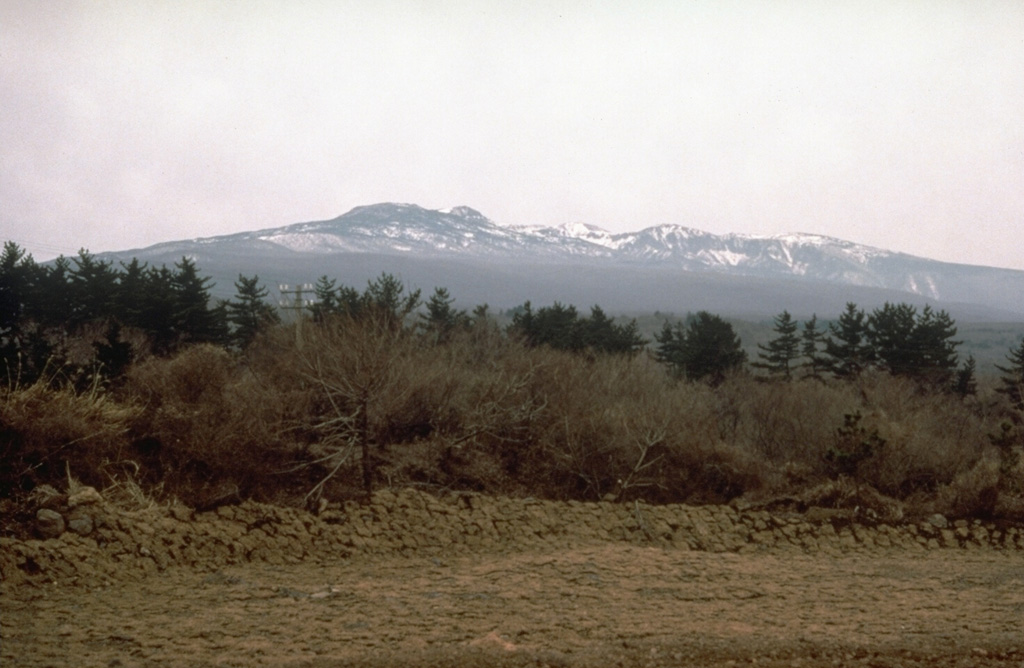
The Global Volcanism Program has no activity reports available for Halla.
The Global Volcanism Program has no Weekly Reports available for Halla.
The Global Volcanism Program has no Bulletin Reports available for Halla.
|
|
||||||||||||||||||||||||||||
There is data available for 4 confirmed eruptive periods.
1007 Confirmed Eruption (Explosive / Effusive)
| Episode 1 | Eruption (Explosive / Effusive) | |||||||||||||||||||
|---|---|---|---|---|---|---|---|---|---|---|---|---|---|---|---|---|---|---|---|
| 1007 - Unknown | Evidence from Observations: Reported | ||||||||||||||||||
| Eruptions of basaltic pyroclastic cones on the flanks took place in 1007 CE (Tomita, 1969; Lee, 1982). | |||||||||||||||||||
|
List of 2 Events for Episode 1
|
|||||||||||||||||||
1002 Confirmed Eruption (Explosive / Effusive)
| Episode 1 | Eruption (Explosive / Effusive) | |||||||||||||||||||
|---|---|---|---|---|---|---|---|---|---|---|---|---|---|---|---|---|---|---|---|
| 1002 - Unknown | Evidence from Observations: Reported | ||||||||||||||||||
| Eruptions of basaltic pyroclastic cones on the flanks took place in 1002 CE (Tomita, 1969; Lee, 1982). | |||||||||||||||||||
|
List of 2 Events for Episode 1
|
|||||||||||||||||||
2050 BCE ± 200 years Confirmed Eruption (Explosive / Effusive)
| Episode 1 | Eruption (Explosive / Effusive) | SW flank (Songaksan tuff ring) | |||||||||||||||||||||||||||||||||||||||||||
|---|---|---|---|---|---|---|---|---|---|---|---|---|---|---|---|---|---|---|---|---|---|---|---|---|---|---|---|---|---|---|---|---|---|---|---|---|---|---|---|---|---|---|---|---|
| 2050 BCE ± 200 years - Unknown | Evidence from Isotopic: 14C (uncalibrated) | |||||||||||||||||||||||||||||||||||||||||||
| The Songkaksan tuff ring, forming a peninsula on the SW tip of the island, was dated at 3,900 ± 100 and 4,090 ± 90 years BP from shells in the overlying sedimentary formation thought to immediately succeed formation of the tuff ring (Sohn et al., 2003). Formation of the tuff ring was followed by the growth of small scoria cones and extrusion of a lava flow. | ||||||||||||||||||||||||||||||||||||||||||||
|
List of 7 Events for Episode 1 at SW flank (Songaksan tuff ring)
|
||||||||||||||||||||||||||||||||||||||||||||
2830 BCE ± 50 years Confirmed Eruption (Explosive / Effusive)
| Episode 1 | Eruption (Explosive / Effusive) | NE flank (Ilchulbong tuff cone) | |||||||||||||||||||||||||||||||||
|---|---|---|---|---|---|---|---|---|---|---|---|---|---|---|---|---|---|---|---|---|---|---|---|---|---|---|---|---|---|---|---|---|---|---|
| 2830 BCE ± 50 years - Unknown | Evidence from Isotopic: 14C (uncalibrated) | |||||||||||||||||||||||||||||||||
| A radiocarbon date of 4,780 ± 60 years BP was obtained from shells in the Sinyangri Formation, resulting from erosion of deposits of the Ilchulbong tuff cone and thought to immediately succeed formation of the tuff cone (Sohn et al., 2003). Younger dates of 4,400-1,500 years BP were also obtained from the reworked material. The tuff cone formed in shallow sea water at the NE tip of Cheju Island (Sohn, 1996). | ||||||||||||||||||||||||||||||||||
|
List of 5 Events for Episode 1 at NE flank (Ilchulbong tuff cone)
|
||||||||||||||||||||||||||||||||||
This compilation of synonyms and subsidiary features may not be comprehensive. Features are organized into four major categories: Cones, Craters, Domes, and Thermal Features. Synonyms of features appear indented below the primary name. In some cases additional feature type, elevation, or location details are provided.
Synonyms |
||||
| Cheju-do | Jeju | ||||
Cones |
||||
| Feature Name | Feature Type | Elevation | Latitude | Longitude |
| Dangsanbong | Tuff cone | 148 m | ||
| Dansan | Tuff cone | |||
| Guduack | Cone | |||
| Huckack | Cone | |||
| Ilchulbong | Tuff cone | 180 m | ||
| Jueockack | Cone | |||
| Sangumburi | Cone | 308 m | 33° 26' 0.00" N | 126° 42' 0.00" E |
| Soengpanack | Vent | |||
| Songaksan | Tuff ring | 104 m | 33° 12' 0.00" N | 126° 22' 30.00" E |
| Suwolbong | Tuff ring | 78 m | 33° 17' 0.00" N | 126° 10' 0.00" E |
| Udo | Tuff cone | 132 m | ||
| Yongmeori | Tuff ring | 33° 14' 0.00" N | 126° 19' 0.00" E | |
Craters |
||||
| Feature Name | Feature Type | Elevation | Latitude | Longitude |
| Backlockdam | Crater | |||
Domes |
||||
| Feature Name | Feature Type | Elevation | Latitude | Longitude |
| Hodo | Dome | |||
| Rimdo | Dome | |||
| Sanbangsan | Dome | 395 m | 33° 14' 0.00" N | 126° 19' 0.00" E |
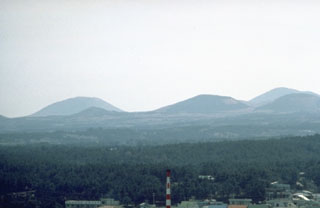 A cluster of scoria cones on the SW rift of Halla shield volcano is part of more than 360 flank cones that were erupted during the third and last stage of activity. Most of the cones were built along the SW-NE-trending rift zone that forms the axis of the island. The basaltic scoria cones are typically 150-200 m in height and are relatively uneroded.
A cluster of scoria cones on the SW rift of Halla shield volcano is part of more than 360 flank cones that were erupted during the third and last stage of activity. Most of the cones were built along the SW-NE-trending rift zone that forms the axis of the island. The basaltic scoria cones are typically 150-200 m in height and are relatively uneroded.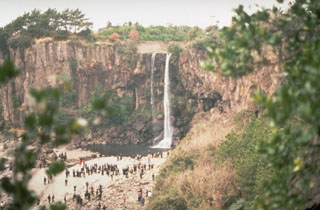 A waterfall plunging over a trachytic lava flow is a popular tourist destination on Cheju Island. An extensive lava plateau underlies the Halla shield volcano and extends to the coast of the 40 x 80 km island. The volcano dominates the center of the island and has been active from the Pleistocene until historical time.
A waterfall plunging over a trachytic lava flow is a popular tourist destination on Cheju Island. An extensive lava plateau underlies the Halla shield volcano and extends to the coast of the 40 x 80 km island. The volcano dominates the center of the island and has been active from the Pleistocene until historical time. The massive Halla shield volcano, seen here from the south, forms much of the 40 x 80 km Cheju Island, which lies 90 km S of the Korean Peninsula. More than 360 late-Pleistocene and Holocene basaltic cones on the flanks of the low-angle volcano were erupted primarily along the long axis of the NE-SW-trending island. Most of these are scoria cones, but about 10 along the coast are Pleistocene tuff rings and tuff cones. Flank eruptions continued into historical time, with the final two taking place during the 11th century.
The massive Halla shield volcano, seen here from the south, forms much of the 40 x 80 km Cheju Island, which lies 90 km S of the Korean Peninsula. More than 360 late-Pleistocene and Holocene basaltic cones on the flanks of the low-angle volcano were erupted primarily along the long axis of the NE-SW-trending island. Most of these are scoria cones, but about 10 along the coast are Pleistocene tuff rings and tuff cones. Flank eruptions continued into historical time, with the final two taking place during the 11th century.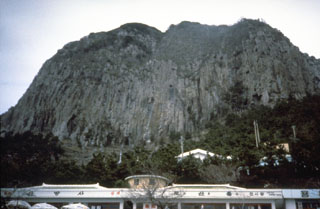 Prominent columnar jointing is visible on the steep sides of a trachytic lava dome on the southern coast of Cheju Island. A cluster of trachytic lava domes were erupted near the end of the second stage of activity of Halla, during which the shield volcano was formed in the center of the island.
Prominent columnar jointing is visible on the steep sides of a trachytic lava dome on the southern coast of Cheju Island. A cluster of trachytic lava domes were erupted near the end of the second stage of activity of Halla, during which the shield volcano was formed in the center of the island.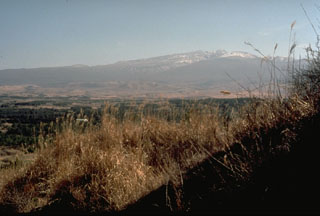 Snow-capped Halla shield volcano is seen here from the north, near Cheju city, the largest on Cheju Island. Voluminous lava flows and an underlying lava plateau form the entire 40 x 80 km island. The volcano is capped by the 400-m-wide Backlockdam summit crater and its flanks contain hundreds of cones, some of which form small offshore islands.
Snow-capped Halla shield volcano is seen here from the north, near Cheju city, the largest on Cheju Island. Voluminous lava flows and an underlying lava plateau form the entire 40 x 80 km island. The volcano is capped by the 400-m-wide Backlockdam summit crater and its flanks contain hundreds of cones, some of which form small offshore islands.There are no samples for Halla in the Smithsonian's NMNH Department of Mineral Sciences Rock and Ore collection.
| Copernicus Browser | The Copernicus Browser replaced the Sentinel Hub Playground browser in 2023, to provide access to Earth observation archives from the Copernicus Data Space Ecosystem, the main distribution platform for data from the EU Copernicus missions. |
| MIROVA | Middle InfraRed Observation of Volcanic Activity (MIROVA) is a near real time volcanic hot-spot detection system based on the analysis of MODIS (Moderate Resolution Imaging Spectroradiometer) data. In particular, MIROVA uses the Middle InfraRed Radiation (MIR), measured over target volcanoes, in order to detect, locate and measure the heat radiation sourced from volcanic activity. |
| MODVOLC Thermal Alerts | Using infrared satellite Moderate Resolution Imaging Spectroradiometer (MODIS) data, scientists at the Hawai'i Institute of Geophysics and Planetology, University of Hawai'i, developed an automated system called MODVOLC to map thermal hot-spots in near real time. For each MODIS image, the algorithm automatically scans each 1 km pixel within it to check for high-temperature hot-spots. When one is found the date, time, location, and intensity are recorded. MODIS looks at every square km of the Earth every 48 hours, once during the day and once during the night, and the presence of two MODIS sensors in space allows at least four hot-spot observations every two days. Each day updated global maps are compiled to display the locations of all hot spots detected in the previous 24 hours. There is a drop-down list with volcano names which allow users to 'zoom-in' and examine the distribution of hot-spots at a variety of spatial scales. |
|
WOVOdat
Single Volcano View Temporal Evolution of Unrest Side by Side Volcanoes |
WOVOdat is a database of volcanic unrest; instrumentally and visually recorded changes in seismicity, ground deformation, gas emission, and other parameters from their normal baselines. It is sponsored by the World Organization of Volcano Observatories (WOVO) and presently hosted at the Earth Observatory of Singapore.
GVMID Data on Volcano Monitoring Infrastructure The Global Volcano Monitoring Infrastructure Database GVMID, is aimed at documenting and improving capabilities of volcano monitoring from the ground and space. GVMID should provide a snapshot and baseline view of the techniques and instrumentation that are in place at various volcanoes, which can be use by volcano observatories as reference to setup new monitoring system or improving networks at a specific volcano. These data will allow identification of what monitoring gaps exist, which can be then targeted by remote sensing infrastructure and future instrument deployments. |
| Volcanic Hazard Maps | The IAVCEI Commission on Volcanic Hazards and Risk has a Volcanic Hazard Maps database designed to serve as a resource for hazard mappers (or other interested parties) to explore how common issues in hazard map development have been addressed at different volcanoes, in different countries, for different hazards, and for different intended audiences. In addition to the comprehensive, searchable Volcanic Hazard Maps Database, this website contains information about diversity of volcanic hazard maps, illustrated using examples from the database. This site is for educational purposes related to volcanic hazard maps. Hazard maps found on this website should not be used for emergency purposes. For the most recent, official hazard map for a particular volcano, please seek out the proper institutional authorities on the matter. |
| IRIS seismic stations/networks | Incorporated Research Institutions for Seismology (IRIS) Data Services map showing the location of seismic stations from all available networks (permanent or temporary) within a radius of 0.18° (about 20 km at mid-latitudes) from the given location of Halla. Users can customize a variety of filters and options in the left panel. Note that if there are no stations are known the map will default to show the entire world with a "No data matched request" error notice. |
| UNAVCO GPS/GNSS stations | Geodetic Data Services map from UNAVCO showing the location of GPS/GNSS stations from all available networks (permanent or temporary) within a radius of 20 km from the given location of Halla. Users can customize the data search based on station or network names, location, and time window. Requires Adobe Flash Player. |
| DECADE Data | The DECADE portal, still in the developmental stage, serves as an example of the proposed interoperability between The Smithsonian Institution's Global Volcanism Program, the Mapping Gas Emissions (MaGa) Database, and the EarthChem Geochemical Portal. The Deep Earth Carbon Degassing (DECADE) initiative seeks to use new and established technologies to determine accurate global fluxes of volcanic CO2 to the atmosphere, but installing CO2 monitoring networks on 20 of the world's 150 most actively degassing volcanoes. The group uses related laboratory-based studies (direct gas sampling and analysis, melt inclusions) to provide new data for direct degassing of deep earth carbon to the atmosphere. |
| Large Eruptions of Halla | Information about large Quaternary eruptions (VEI >= 4) is cataloged in the Large Magnitude Explosive Volcanic Eruptions (LaMEVE) database of the Volcano Global Risk Identification and Analysis Project (VOGRIPA). |
| EarthChem | EarthChem develops and maintains databases, software, and services that support the preservation, discovery, access and analysis of geochemical data, and facilitate their integration with the broad array of other available earth science parameters. EarthChem is operated by a joint team of disciplinary scientists, data scientists, data managers and information technology developers who are part of the NSF-funded data facility Integrated Earth Data Applications (IEDA). IEDA is a collaborative effort of EarthChem and the Marine Geoscience Data System (MGDS). |